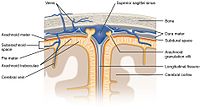
Photo from wikipedia
Background: Idiopathic intracranial hypertension (IIH) is well-described entity in literature. However, large studies on clinical and radiological profile are still very few from the Indian subcontinent. Aims: To analyze the… Click to show full abstract
Background: Idiopathic intracranial hypertension (IIH) is well-described entity in literature. However, large studies on clinical and radiological profile are still very few from the Indian subcontinent. Aims: To analyze the clinical and radiological profile of IIH and correlation of various clinical and radiological parameters with papilledema and CSF opening pressure. Setting and Design: Hospital-based observational, descriptive study. Materials and Methods: This study analyzed 122 patients admitted in the department of Neurology (from January 2014 to December 2018) for detailed history, clinical examination, and neuroimaging. CSF manometry and routine CSF analysis were done. All participants met the modified Dandy criteria. Patients with secondary causes of raised ICP and primary ocular pathology were excluded. Statistical Analysis Used: Descriptive statistics and Chi-square test. Results: Among 122 cases 86 (70.49%) were females. The mean age was 33 years. 62 (50.82%) cases were obese. Headache was the most common symptom (114/122; 93.44%). Bilateral papilledema was noted in 114 (93.44%) cases. Higher grades of papilledema had a correlation with higher CSF opening pressure. Empty sella was the most common radiological finding (100/122; 81.97%). All radiological findings except empty sella had a correlation with higher CSF opening pressure. Conclusion: IIH typically affects obese females of childbearing age group. However, it is not uncommon in the nonobese and male sex. Obesity may not be a dominant risk factor for the development of IIH in the Indian subcontinent. Cases with normal BMI and male sex with clinical features of raised intracranial pressure and normal neuroimaging should also be evaluated for IIH. Cases with refractory headache and empty sella on MRI should be evaluated for IIH.
Journal Title: Neurology India
Year Published: 2022
Link to full text (if available)
Share on Social Media: Sign Up to like & get
recommendations!